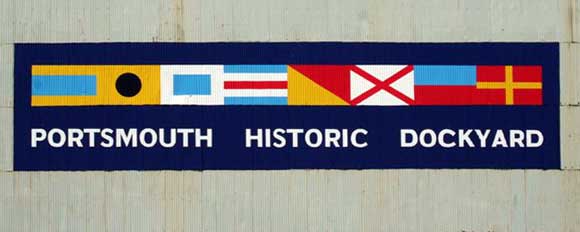
In any list of the world’s major maritime heritage sites, Portsmouth must command a place in the top ten. Rarely can you see so much in one place, so when our Editor suggested I might like to do a feature on the Historic Dockyard from a modelmaker’s viewpoint, I didn’t need asking twice.
Portsmouth has always been known as the home of the Royal Navy and over the centuries the dockyard has been greatly expanded and its role extended to building ships as well as to base and repair them. In recent years with the alarming shrinkage of the navy, the very existence of the dockyard as a military facility has come under threat, although the intention to base the new aircraft carriers there seems to have given it a reprieve for the time being. Interestingly Portsmouth saw a return to shipbuilding after almost 40 years with the launch of H.M.S. Clyde, the new Falklands Protection Vessel, in 2006.
It has for many years been possible to visit H.M.S. Victory, but the addition of new attractions since the 1980’s has led to the growth of the dockyard as a tourist destination in its own right and the ‘Portsmouth Historic Dockyard’, as it is now officially known, is one of the country’s top ranked heritage sites. Re-arrangement of the internal site layout has meant that the public effectively have the run of the area from the old main Victory Gate on Portsmouth Hard right down to the Victory herself. Security fencing separates the operational and tourist areas, but it is still possible to see quite a bit of the former and the warships in port in a way that would be unthinkable in most other countries. Entry to the Historic Dockyard is free, but there is a charge for the main attractions, either individually or all inclusive. Further details are given at the end of this article but you can also visit www.historicdockyard.co.uk/ for the latest updates.
Enjoy more Model Boats Magazine reading in the monthly magazine.
Click here to subscribe & save.
Of course Portsmouth is best known for its ships, Victory, Warrior and Mary Rose, but there are many other attractions in the Dockyard, including literally hundreds of magnificent models from all periods – mostly warships of course. In the following sections I will give a general run down of what there is to see, with particular emphasis on those sights of interest to modellers.
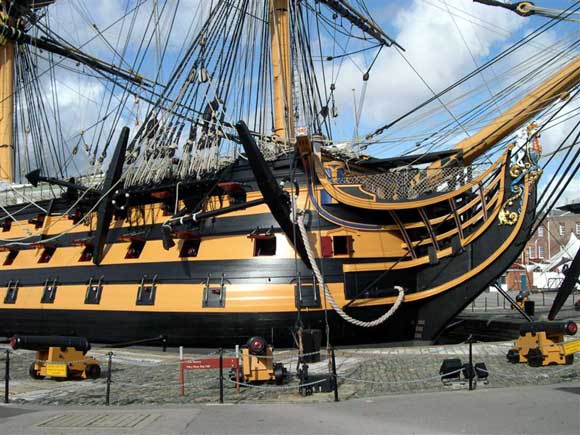
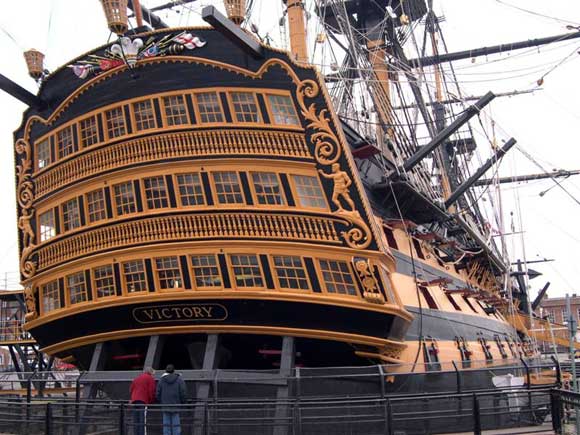
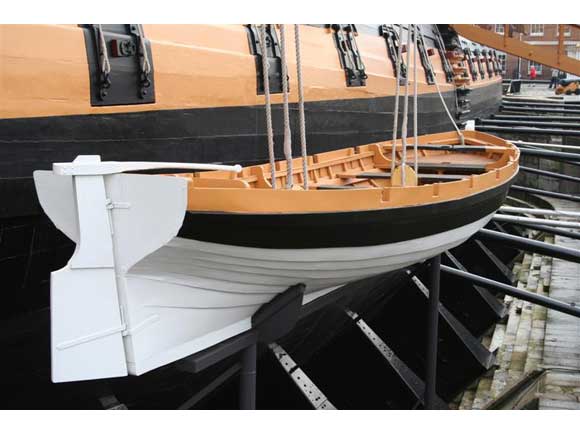
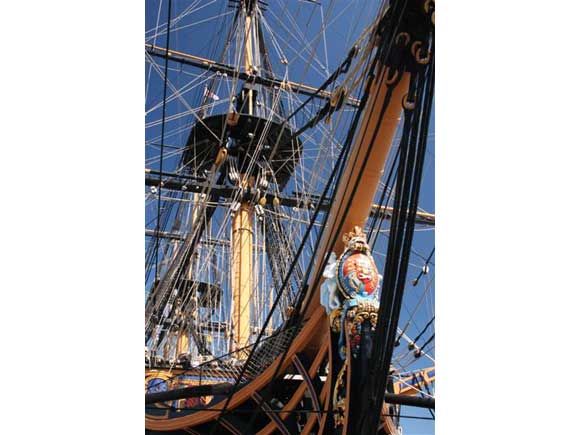
Pic 2: Victory makes a fine sight in the sunshine. Pic 3: Stern of Victory showing the pronounced curvature that isn’t always properly reproduced on models. Pic 4: Victory’s boats can sometimes be seen suspended from her davits. Pic 5: Bow and figurehead of H.M.S. Victory.
H.M.S. Victory
Nelson’s flagship is the jewel in the dockyard crown and deservedly so. Seen on a sunny day with her buff and black hull and masts, yards and rigging against a blue sky, she is a stunning sight. A huge White Ensign flying from her taffrail confirms that she is still very much in commission as the Flagship Commander in Chief Naval Home Command and you can frequently observe an admiral’s flag flying from the masthead as well. Although there is some doubt as to just how much of the Victory you see is of original material, the ship herself has been restored to her appearance as at the Battle of Trafalgar. As such she is a very good reference source if you are building a model of her, either from scratch or from one of the several kits available marketed by Panart, Caldercraft and Corel. One thing I have noticed about Victory models over the years is that the curve of the stern windows across the transom appears to be more pronounced on the real thing compared with many of the models where it is often much flatter. Access to Victory varies according to the time of year and busy periods as listed on the website.
Sometimes you get a conducted tour in small groups, whilst at others a free flow system operates whereby you go round by yourself with guides stationed at various places to answer questions. When there are a lot of visitors you do tend to get chivvied round with insufficient time to take in your surroundings and absorb the atmosphere which can be frustrating. The best thing is to get to the dockyard early during a free flow period and head straight for Victory. That way you are likely to beat the crowds and will have plenty of time to see everything between the hold and the upper deck. When researching this article I was able to take photos all over the ship for private use only, with the exception of Nelson’s ‘shrine’ on the Orlop deck, but that may not always be the case. Obviously, decent photos of the interior and deck fittings, plus the masts and rigging can be an invaluable aid to modelling and you can get a lot of excellent shots from the surrounding area of the hull and its fittings including the anchors and figurehead. There are also various cannon surrounding the ship and sometimes you can see one of her boats suspended from davits aft. The whole thing is a feast for the photographer. Other Victory material can be found in the R.N. Museum, including models, and in the R.N. Shop where I picked up a remaindered copy of Alan McGowan’s excellent and superbly illustrated book on the construction, career and restoration of the ship for a quarter of the original price. The book is worth having for the drawings alone.
Your ticket to the Victory also includes the ship’s ‘Trafalgar Sail’ stored in the R.N. Museum building nearby. This is Victory’s fore topsail, preserved since the battle and still bearing the damage and shot holes from the Battle of Trafalgar. It is kept in a dimly lit climate controlled loft area with an audio visual presentation telling of its history.
H.M.S. Warrior
Berthed at a jetty at the entrance to the Dockyard, Warrior makes an immediate impact on the senses. This is a seriously large ship. Built in 1860 as Britain’s first iron hulled armoured warship, she was a quantum leap beyond the old ‘Wooden Walls’ comparable to that of the Dreadnought over her own predecessors later in 1905. In active service for ten years followed by twelve in the Coastguard Reserve, she finally ended up as an oil jetty in Milford Haven from where she was rescued in 1979. Restored to her 1860 condition at Hartlepool, she was towed to her present berth in Portsmouth in 1987. Although the hull is original, all the rigging, fittings and armament have been reconstructed from contemporary sources of information, albeit not always from similar materials. For example most of the huge guns you can see are GRP replicas, although you would be hard put to tell the difference, so well has the job been done. Down in the engine room there is a working replica of the enormous Penn Trunk Engine that originally powered the ship and next to that you can wander through the stokehold from which the 10 rectangular boilers were fired. As you queue for your ticket you will see William Mowll’s 1/48th scale working model of the ship, the construction of which was described in what was perhaps the longest running series ever in Model Boats. The articles were later published as a book which at the time of writing is available to buy in the dockyard. It makes an interesting comparison going from Victory to Warrior. Everything is on a much more massive scale, from the largest anchors ever to be hand raised to the quadruple steering wheels which are repeated at three deck levels. The 26 ton propeller reputedly needed 400 men to raise and lower it. Once on board you begin to appreciate just how much larger than Victory she is. The flush deck is vast with just a couple of small open bridges to con her. The seamen at the wheel would have had no view of the sea at all due to the high bulwarks and must have relied solely upon the compasses and orders from the officers on the flying bridge above. There is an open topped armoured conning position immediately ahead of the wheel, but it is hard to imagine how the ship could have been controlled from it. As with Victory, the ship is a mine of information for modellers interested in the period with a fine variety of fittings and guns of all types and sizes. Below decks the ship has been fitted out internally down to the smallest detail, including the crew’s eating utensils on the mess tables. Virtually the whole ship is accessible to the public and you can just wander around at will. Photography is allowed for private purposes only.
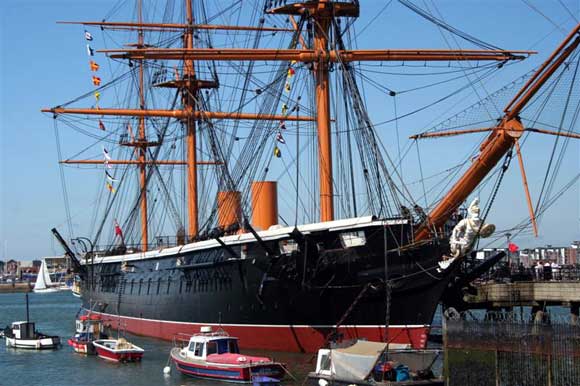
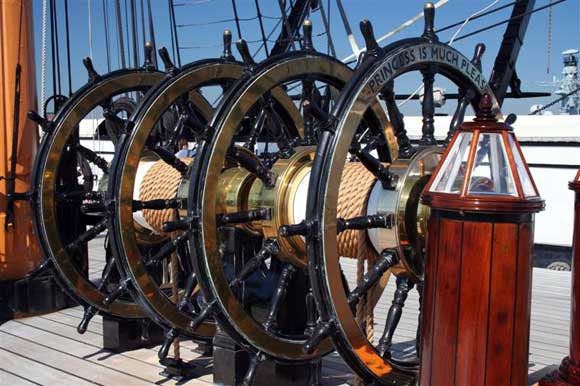
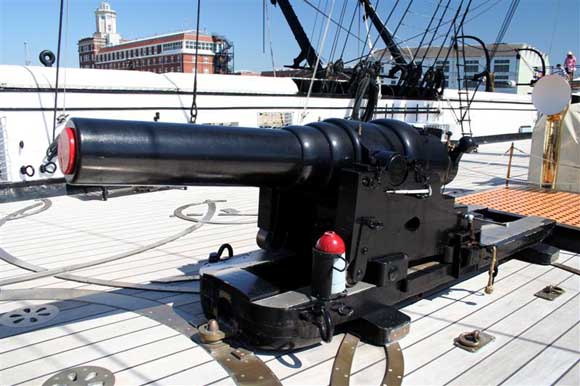
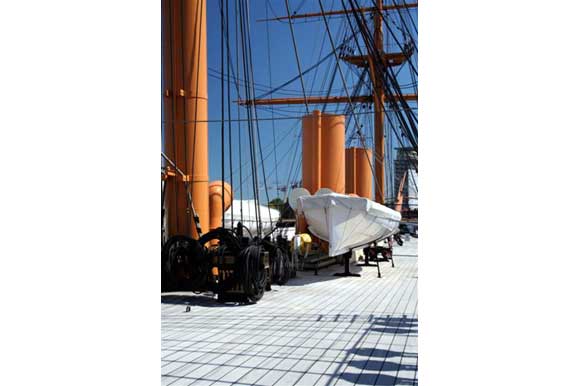
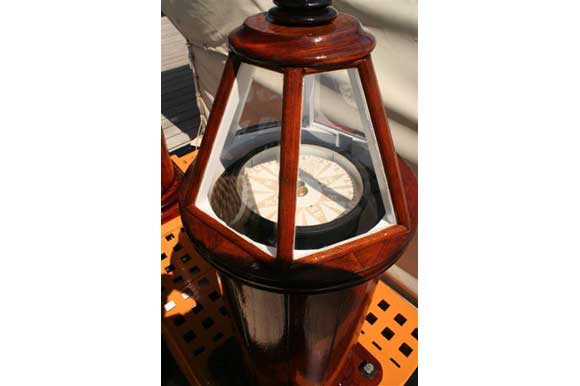
Pic 6: Berthed at the entrance to the Dockyard, Warrior is the very essence of the Mid-Victorian Navy. Pic 7: The quadruple banked ship’s wheel needed for hand steering the ship. This is duplicated on two lower decks. Pic 8: The Armstrong 110pdr rifled breech loading stern chaser. Warrior mounted ten of these new weapons, but they were not an unqualified success. The remaining armament consisted of 26 times 68pdr cannon. Victory carried 32pdrs on her lower gun deck at Trafalgar. Pic 9: The sweeping length of the flush upper deck is apparent in this shot. Pic 10: Functional but almost a work of art in its own right, one of Warrior’s binnacles. In addition to those adjacent to the ship’s wheel, two more were mounted on the flying bridges spanning the bulwarks and one on the mizzen fighting top.
Mary Rose
The third of Portsmouth’s ‘big three’ is Henry VIII’s pride and joy, or some of it anyway. About 40% of the ship was recovered from the Solent in 1982 and now reposes in a covered drydock next to the Victory. Since being raised, the ship has been subjected to a constant spray of polyethylene glycol to preserve her timbers and it is quite difficult to get a good impression of her from the glassed in viewing gallery. Persevere however and the size and shape of the vessel looms out of the murk and you find yourself looking at a longitudinal cross section of this Tudor ship which sank in 1545 under the gaze of her watching monarch while in action against the French fleet just off Southsea. Conventional wisdom has it that she was overloaded with ordnance and fighting men and a gust of wind brought her lower gunports under, whereupon she quickly filled and sank, taking most of her crew with her. Today, the Mary Rose is interesting to see on her own account, but what really brings her to life are the exhibits in the Mary Rose Museum near the Dockyard gate. Her loss in action meant that a complete microcosm of the Tudor age was preserved in the Solent ooze over the centuries. Not only metal and wood artifacts have survived, but also clothing and many other day to day domestic objects as well. Looking at these, it is hard not to feel that these people were very like ourselves in many ways, while the technologies they employed were both complex and ingenious. Many human remains were also discovered, including those of archers trapped beneath anti-boarding netting when the ship went down and they have been subjected to scientific study. It is probably true to say that the Mary Rose does not offer much for the average modelmaker, but the ship and the museum do make for a fascinating visit for anyone. There are ambitious plans to develop the drydock and its surroundings to provide enhanced viewing of the ship and incorporate a state of the art museum complex to display the artifacts associated with her.
Other vessels
Whilst Victory, Warrior and Mary Rose are the headline attractions, there are a number of other full size vessels of interest to modellers. Chief among these is the H.M.S. M33, the last surviving example of a WWI monitor currently undergoing preservation. She had an active war, being employed to support the Gallipoli campaign and later served off Northern Russia in 1919. She afterwards served in various roles until disposed of in 1987 when she was taken to Hartlepool with a view to future preservation. In 1990 she was purchased by Hampshire County Council and in 1997 was moved to No.1 drydock on the opposite side of Victory to Mary Rose, where restoration has been proceeding slowly ever since, despite some funding problems. Although the vessel itself is not yet open to the public, good views can be obtained from either side of the drydock, frequently against the dramatic backdrop of one of the Navy’s carriers or large assault ships. Looking at her, the simple, even crude, construction becomes apparent, illustrating how it was possible to build these vessels in a very short timescale. There is plenty of detail for the modelmaker to take note of and the ship is very similar to Editor Paul Freshney’s M15, which was featured in Model Boats a year or so back.
Other full size vessels are rather smaller with a collection afloat in the mast pond near the Dockyard entrance. This notably includes a Landing Craft (Infantry) plus several large ship’s boats of various types, all easily photographed. Opposite, in Boathouse No.4 you can find the 31ft Royal Life Cutter ‘Osborne’ built in 1896 which served on three Royal Yachts and survived a varied private career before coming to Portsmouth. The RN Museum also contains some full size boats in the Victory Gallery.
Other attractions include ‘Action Stations’ which has a variety of naval simulations for young people and the not so young. Here you can fly a helicopter, scale a cliff and enter the world of marine technology. Aimed firmly at the younger generation, it is full of audio visual displays and exhibits with a ‘wow’ factor designed around the activities of the Navy and Royal Marines. Rather more sedate, but just as interesting to the older visitor is the Dockyard Apprentice Exhibition, which showcases in a series of full size dioramas the skills which made Portsmouth the greatest naval shipbuilding centre in the world. The exhibition also features a number of models of ships of the post war navy.
Models in the Dockyard
As well as the full size vessels there are literally hundreds of models to be seen in the dockyard. Naturally they are nearly all of naval subjects with some notable exceptions. Most are displayed within the R.N. Museum but you will find them all over the place including two excellent models of the Royal Yacht Britannia and the Falklands aircraft carrier H.M.S. Hermes displayed on a plinth right in the middle of the main cafeteria.
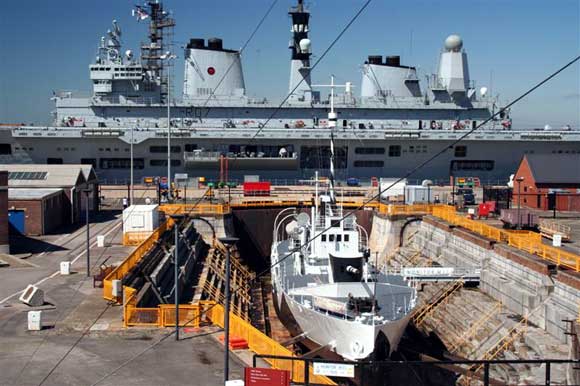
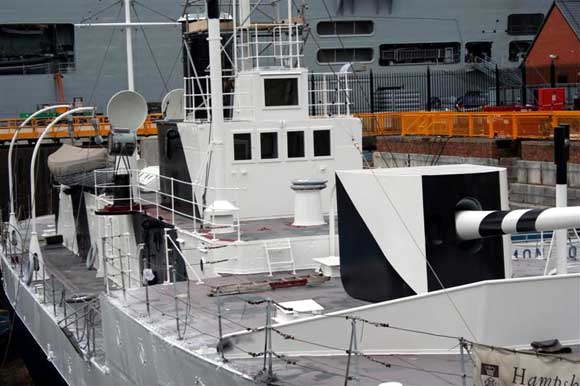
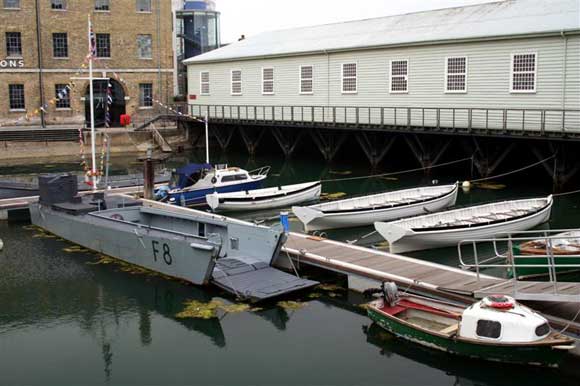
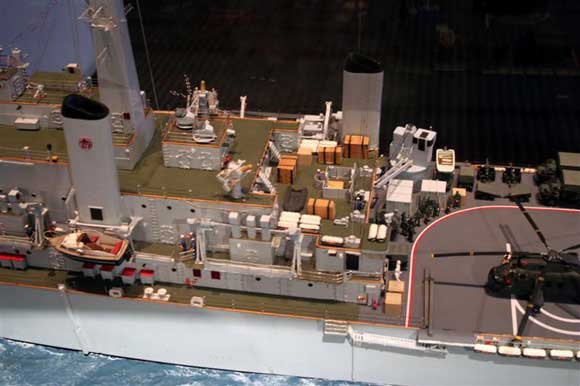
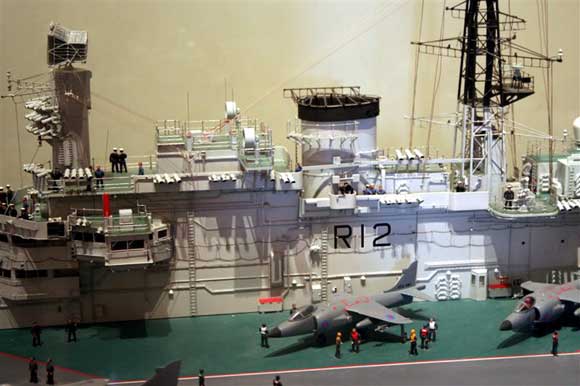
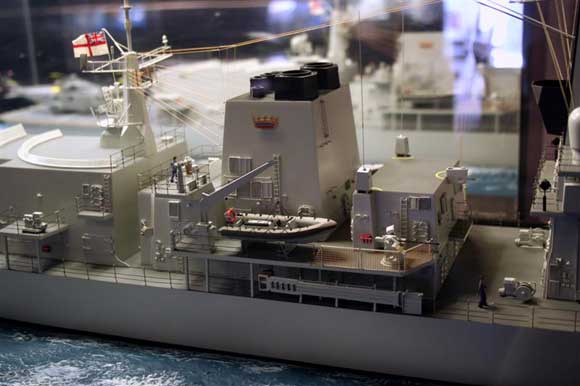
Pic 11: Old and new. The Monitor H.M.S. M33 makes a fascinating contrast with the current Fleet Flagship, H.M.S. Ark Royal. Pic 12: H.M.S. M33 has now been repainted in her WW1 camouflage scheme. The simple construction is readily apparent. Pic 13: Ships boats and Landing Craft (Infantry) in the Mast Pond. This was originally used to store ship’s spars and has a tunnel connecting it to the waterfront. Pic 14: A fine model of H.M.S. Fearless – one of many fine models in the R.N. Museum Falklands exhibition. Pic 15: The Falklands Fleet Flagship H.M.S. Hermes. Pic 16: A more modern R.N. subject – H.M.S. Iron Duke.
The Royal Naval Museum
Half way along the seaward side of the dockyard towards the Victory, lies the Royal Naval Museum which has close connections with the National Maritime Museum. In some ways the museum has been a bit overlooked in the past, worthy but a little dull to the average visitor. Now though, things have changed. When researching this article I found it much updated since my previous visit some years ago. Somewhat to my disappointment most of the models of the Victorian to 1970’s period have been put into storage, although it is likely that they will make an appearance as part of future themed exhibitions. However, this loss has been offset by some excellent displays of ships of the Falklands conflict and the modern navy. These are contained within the 20th century gallery. The Falklands special exhibition, entitled ‘Task Force South’ runs until the end of February 2008. The other galleries are devoted to the Sailing Navy, covering ships of all types and periods, the Nelson Gallery which is a shrine to the man himself, and the Victory Gallery which is largely concerned with his flagship, but which also contains many other interesting exhibits and models including the ‘Trafalgar Experience’ which finishes with a view of Wylie’s enormous Trafalgar Panorama painting. The displays in all the main galleries are both attractive and informative and should not be missed.
Many of the exhibits in the R.N. Museum are models of first class quality and historical value and will be of great interest to any modelmaker, particularly those who like modern Royal Navy warships. The Victory Gallery contains some very large sailing ship models and a wonderful diorama of the launch of an earlier H.M.S. Warrior of 74 guns depicted in 1781. The upper level has a display of figureheads and some full size boats including the State Barge of King Charles II. There is also an outside terrace at first floor level which affords good views over the operational dockyard, Monitor H.M.S. M33 and the Victory.
Between the main R.N. Museum and the Victory gallery is the R.N. Museum Shop formerly known as the Victory Shop. Here you can buy various souvenirs and some model kits, the latter at rather inflated prices, but the best part is the book section where you can frequently obtain high quality technical books at bargain prices. Availability varies during the year, but it is rarely that I go away without making at least one purchase. There is also a good selection of specialist naval books which you would not normally see on the high street. You can spend an hour or so browsing quite easily and spend a fair bit of cash besides!
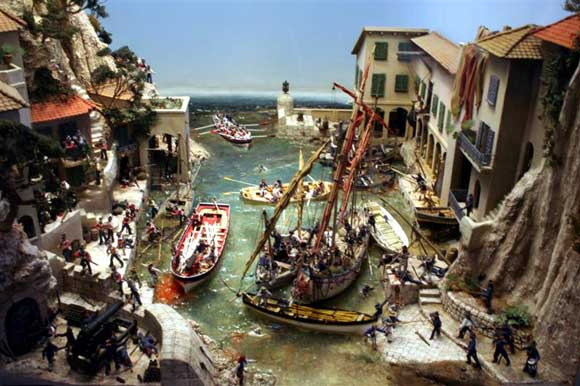
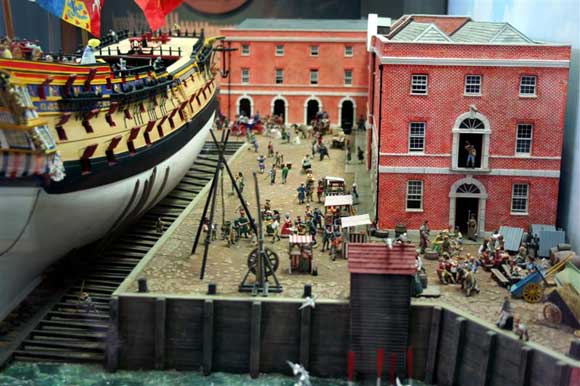
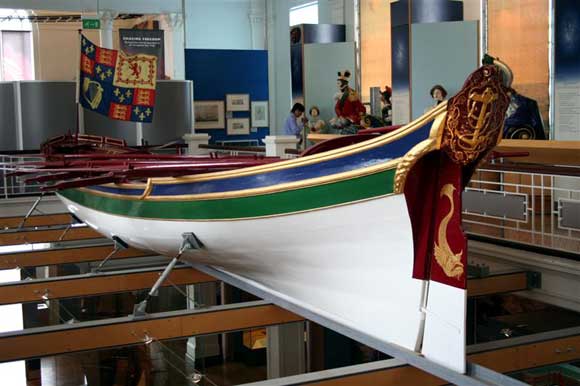
Pic 17: A diorama of boats from offshore warships attacking a Mediterranean fishing port in the Napoleonic period. Pic 18: Diorama of launch of an earlier H.M.S. Warrior (74 guns) in 1781. Pic 19: State Barge of King Charles II displayed in the Victory Gallery of the R.N. Museum.
Special events including model boating
The Dockyard has a regular programme of special events throughout the year, details of which are available on its website or by telephoning the Visitor Centre (see information at the end of this article). More recently these have included model boat displays put on by local clubs. One of my visits when researching this article coincided with some dramatic and very popular naval battle enactments put on by the Portsmouth Model Boat Display team supported by the Surface Warship Association and other local clubs. Many readers will be familiar with these displays, but for those who are not I hope the pictures will give something of a flavour. The on the water modelling activities were supplemented by an exhibition and indoor pool in No.4 Boathouse which included many models on display, the centrepiece of which was Phillip Warren’s well known Matchstick Fleet now numbering over 1,000 models. Trade stands included Macs Mouldings, ModelPower and SHG Marine.
The Historic Dockyard authorities appear to be keen to make model boating displays a regular event in their calendar and to boost the trader attendance. This area is a bit short of dedicated model boating shows and those people I spoke to, all agreed that the Dockyard would make a very prestigious and attractive venue to host an annual show. At the time of writing (September 2007) the Dockyard has provisionally earmarked Sat and Sun 20/21st September 2008 for the next Model Boat Weekend. These dates will be confirmed in due course. In the meantime there are model boat displays planned as part of the ‘Meet Your Navy’ event over 25th-27th July 2008.
Round and about
Portsmouth and Gosport have many attractions as a tourist area besides the Historic Dockyard. Of particular nautical interest are the Spinnaker Tower which offers extensive views over the harbour area and the Solent and the Submarine Museum at Gosport which has a unique collection of submarines, the centrepiece being the post-war H.M.S. Alliance. There is a circular waterbus service which calls at the main places of interest on both sides of the harbour including the Gunwharf shopping centre where you can take a break from historic exhibits, indulge in some retail therapy at the outlet stores and then relax in one of the many waterfront restaurants and cafes and simply watch the busy modern shipping scene.
Getting there
The entrance to the Historic Dockyard is at the northern end of Portsmouth Hard and is the old dockyard Victory main gate. It is just a few minutes walk from Portsmouth Harbour railway station at the opposite end of the Hard. If you are travelling by car, the Dockyard does have its own car park but this can fill up quickly on popular holiday dates. Alternative car parking is available in the nearby NCP and at Gunwharf Quays, but is not particularly cheap. If you know it is likely to be busy then a sensible alternative at weekends is to use commuter parking in one of the nearby railway stations and take the train the rest of the way. Havant is a good option for this.
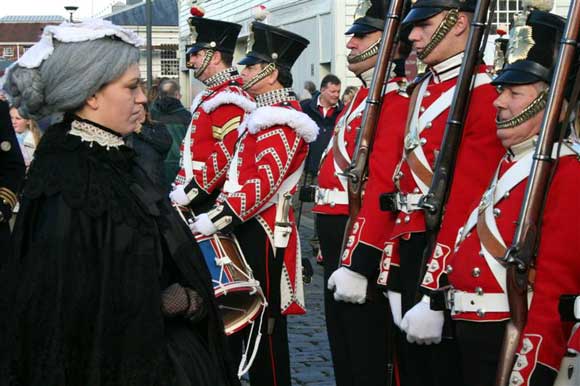
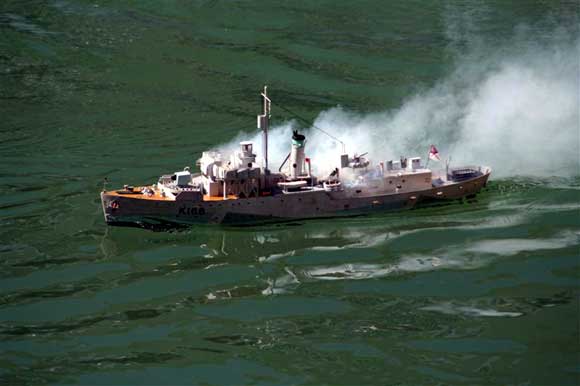
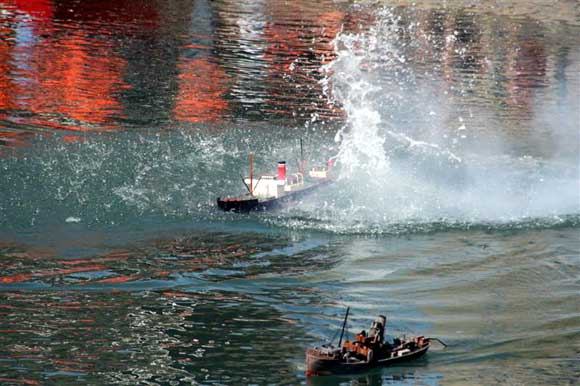
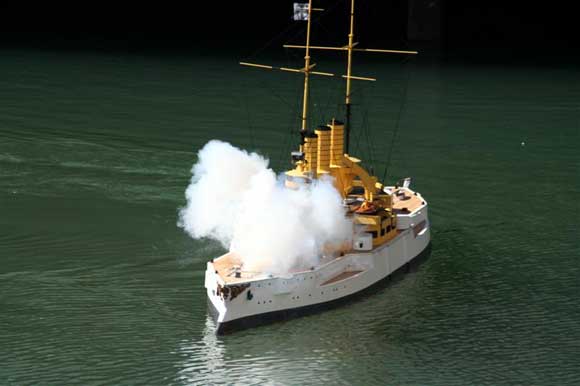
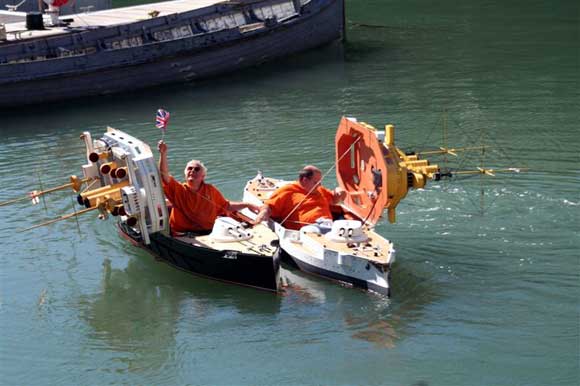
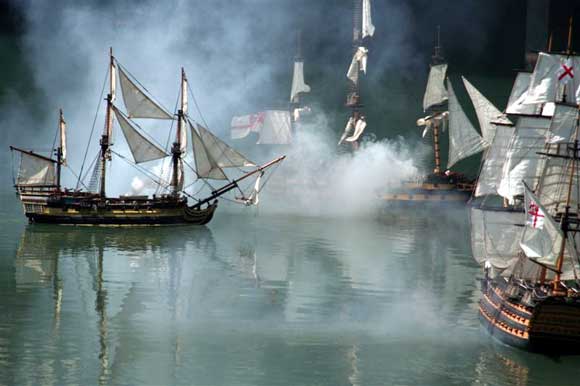

Pic 20: Queen Victoria inspects her troops. A typical scene from one of the Dockyard special events, in this case the Festival of Christmas. Pic 21: Corvette on fire during the WWII convoy action staged by the Portsmouth Model Boat Display Team. Pic 22: Merchantman torpedoed by U-Boat! Pic 23: The German pre-dreadnought Schleswig Holstein comes out with all guns firing only to receive a drubbing from H.M.S. Cornwallis, two of the impressive manned models operated by the Portsmouth club. Pic 24: International relations are restored at the end of the battle! Pic 25: The age of fighting sail perfectly recaptured in miniature. Pic 26: Cannons fire and masts and spars are shot away at the climax of the action!
Getting in
Entry to the Dockyard itself is free, but you do have to pay to visit the main attractions except for the Dockyard Apprentice exhibition. You can do this individually or buy an all inclusive ticket which includes a harbour tour. The latter is valid for one year and includes unlimited entry to Warrior, the RN Museum and Action Stations, plus one entry to each of Victory, Mary Rose and its Museum and a Harbour Tour. The inclusive ticket is best value @ £16.50 for 2007 as you cannot really do the Dockyard justice in one visit and at least two days are necessary to see everything properly. If you just happen to be in the area with limited time, a stroll through the Dockyard is always interesting with the RN Museum and Nauticalia shops plus an Art Gallery well worth a look.
When some events are held, such as the December Festival of Christmas, special ticket prices apply which normally include entry to all the main attractions although on those days entry to the Dockyard itself is not free. Further information on current prices and forthcoming events can be obtained from the Dockyard website or by telephoning the Visitor Centre on 023 9272 8060.
Opening times
The Dockyard opens at 10am every day of the year except Christmas Eve, Christmas Day and Boxing Day. From April to October it closes at 6pm; 5:30pm at other times. Last tickets to the main attractions are sold 90 minutes before the Dockyard closes.
Useful websites
Portsmouth Historic Dockyard: http://www.historicdockyard.co.uk/ HMS Victory: http://www.hms-victory.com/ HMS Warrior: http://www.hmswarrior.org/ Mary Rose: http://www.maryrose.org/ Monitor M33: http://www.hants.org/m33/ Royal Naval Submarine Museum: http://www.rnsubmus.co.uk/ Portsmouth Tourist Attractions: http://www.visitportsmouth.co.uk/ Gosport Tourist Attractions: http://www.discovergosport.co.uk/ Portsmouth Model Boat Display Team: http://www.pmbdt.co.uk/ Surface Warship Association: http://www.warships.org.uk/ Acknowledgements. I would like to thank Zoe Wild of the Historic Dockyard who kindly facilitated my visits, The Warrior Preservation Trust for permission to use photographs taken on board and the staff of the Royal Naval Museum for allowing me to photograph many of the magnificent models and exhibits they have on display.




